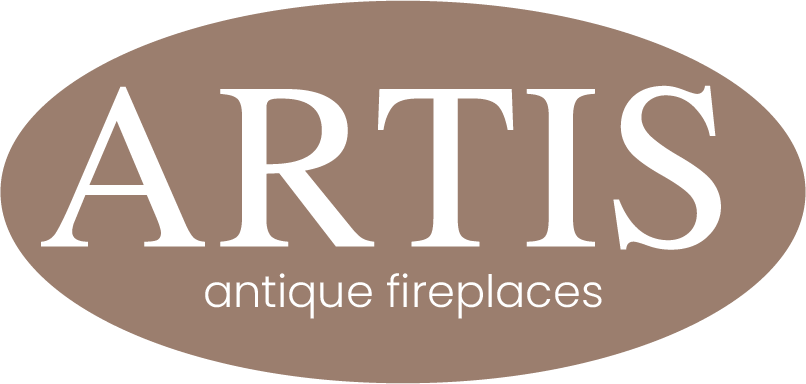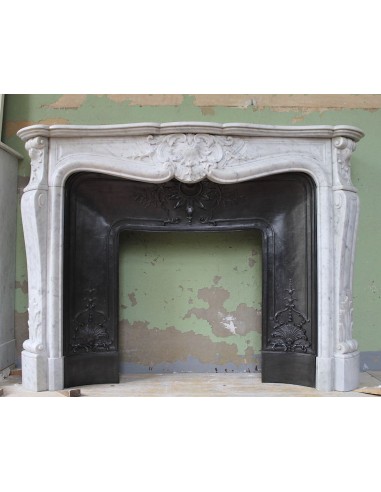The name of this mantel is “Trois Glands,” but be aware that in place of the aforementioned “glands” (acorns) you will always find three (sometimes just two plus a third in bands) floral buds...
An oddity?
Yes, but not the only one in the world of antique fireplaces. For example, the Louis XVI fireplace dubbed “Olive Branch” never has on its front (at least not in 99% of cases) the Olive Branch decoration, but an, equally happily charming, Laurel Branch.
Strange, isn't it?
My pet peeve is that I will most likely die without knowing the reason for these inappropriate names, and know that I have asked, and have been asking for decades, a great many elderly insiders questions along these lines...
In addition to the beautiful front full of many carvings, we have a nice pair of shells on either side of the same front, “nice pair” in that these shells are stylized/interpreted in a leafy way, much finer than the classic shells we may on average come across.
In addition to this, elegant cartouches at the feet and, last but not least, sides that are as ornate as can be...
The marble surfaces at the sides, in fact, are endowed with a shelled design found exclusively in the most important Louis XVs, as indeed our fireplace is.
We cannot fail to mention also its cast iron insert***, which is the one of origin and certainly chosen for the fact that it too, on its legs, has a cartouche made with the same bosses that we find on the front of our “Trois Glands,” bosses by the way less and less hatching (smaller, in short) as the cartouche rises, a “sequence” identical to that of the bosses in the fireplace frieze.
PARISIAN FIND, ITALIAN SCULPTURAL QUALITY, DATE OF BIRTH 1860-80, EXCELLENT OVERALL CONSERVATION.
*** I think it is important to talk to you about something that is increasingly being pointed out by customers interested in buying a fireplace equipped with its counter hearth, this:
“Excuse me, Maurizio, but doesn't it seem to you that the cast iron of the cast iron insert does not perfectly match the marble of the fireplace?!”
“Certainly, Mr. Smith, that it seems to me just as you are saying.... I'll tell you more, I'd be worried if there was perfect collimation (you can tell I'm a literature major, eh.. When have you ever heard the word collimation? Actually I've never heard it either, buth, let's hope it exists) between the two surfaces. And let me explain: Artistic cast iron, after it is poured into the earth that will give it its shape, begins to cool. And there is no Saint to keep it, during its cooling it (the casting) breaks down, shrinks and ... more or less depending on the luck and skill of the master foundryman, a little loses its original lines, both in width as well as in height and depth. Of course, if the shift from the mold measurements is such that the casting object is unusable, well, you throw it back into the furnace for subsequent castings. Never, fortunately, will Perfection be achieved. That can be found in countercuts made nowadays from die-cast aluminum. There is a German company that makes them and sells them for about 5,000 € each, however, try to believe, just seeing them you can taste plastic in your mouth. In any case we have been dealing, for almost half a century now, ONLY ANTIQUE ITEMS, we leave to the Germans - and soon to the Chinese - their vulgar standardized reproductions as MODERNALLY PERFECT. I believe that whoever buys an antique fireplace with its equally antique counter hearth, must accept these fantastic imperfections, indeed must love them, because, if you remember Mr. Smith, the Beauty that the good old days gave us will certainly not be found in the near future. Unfortunately.
Moreover, Mr. Smith, what seems to you to be an imperfection (while it is the sign of something artistic made by hand, with experience, sweat, love and creative ability) can be easily eliminated with a little black putty (very common the one used for flues). In ancient times for these fittings they used refined plaster colored black by a pinch of graphite powder (but any modern black pigment of the kind used for coloring joints in floors/coatings will do just fine). In any case, if ever anyone who mounts has any uncertainty about this spic and span, give us a call and we will easily assist you.
064 AG ANTIQUE LOUIS XV "TROIS GLANDS" FIREPLACE SURROUND IN WHITE CARRARA MARBLE WITH ITS ORIGINAL FLORAL CAST IRON INSER
Louis XV
€14,500.00
No tax
SHARE ON:
Description
Reviews (0)
No reviews




























































































